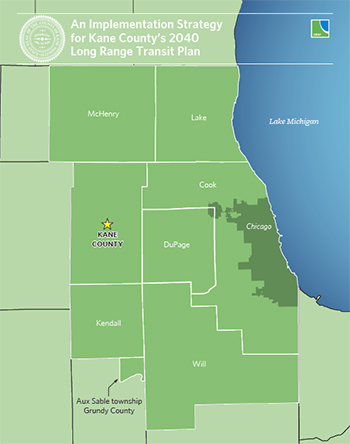 UPDATE: The final implementation strategy report was presented to the Kane County Transportation Committee in June 2015. The document, Implementation of the Kane County 2040 Long Range Transit Plan, can be downloaded here.
UPDATE: The final implementation strategy report was presented to the Kane County Transportation Committee in June 2015. The document, Implementation of the Kane County 2040 Long Range Transit Plan, can be downloaded here.
By the year 2040, Kane County is projected to have 270,000 new residents and 144,000 new jobs, which will have a great impact on travel demand and the County's overall transit system. In 2012, Kane County adopted its 2040 Transportation Plan. The Plan outlines a long-term vision for Kane County, guides transportation infrastructure investments, and contains several components, including a Long Range Transit Plan (LRTP).
The LRTP's objective is to make transit a viable travel option for County residents by improving transit service and achieving the County's other transportation goals, including reducing congestion. The successful implementation of the LRTP, however, depends on creating an integrated process for transit service providers and municipalities to coordinate transit service with land use planning and development. The LRTP identified short- and medium-term strategies centered on changing development patterns, integrating transit with land use planning, improving transit marketing and information, and implementing nontraditional services sponsored by employers and municipalities. The LRTP also identifies specific action steps that Kane County, municipalities, and partner agencies (Pace, Metra, the Regional Transportation Authority, and CMAP) can take to implement the identified strategies.
With the help of CMAP's Local Technical Assistance (LTA) program, Kane County created an implementation strategy that will build upon the principles outlined in the 2040 Transportation Plan to improve public transit options throughout the County and create a land use pattern to support increased transit usage. The implementation strategy specifically addresses high priority action items found within the LRTP, including:
1. A Primary Transit Network (PTN) policy. A PTN is a network of transit corridors planned and developed for the greatest transit ridership and community benefit. The three main objectives for creating a PTN are to:
- Assist the County, municipalities, and regional transit providers in supporting future developments along transit corridors that support cost-effective transit and maximize ridership potential.
- Prioritize physical amenities and other capital expenditures.
- Provide a foundation for the eventual development of other high frequency transit modes.
Priority corridors are those with both community support and the highest potential ridership. The PTN policy identifies potential priority transit corridors and focuses on both service and non-service supportive strategies.
2. A model transit overlay zoning ordinance. This assists the County in encouraging higher-density development and a greater mix of uses within transit-oriented development areas. The intent is that the model language be included in local planning documents for areas within the PTN corridors. In addition, the model ordinance includes language that can be added to municipal comprehensive plans to describe the goals, objectives, and recommendations of PTN corridors. The language will be designed so municipalities can use it as a starting point and then modify it to reflect local circumstances.
Planning Process
The planning process, developed with Kane County staff, involved multiple steps and included input from both municipal staff and residents. The first step involved the creation of an oversight steering committee made up of representatives from municipalities in Kane County, transportation agencies, and County departments, which assisted in shaping the final implementation strategy. The next step entailed the creation of a PTN Corridor Analysis and Development Report. Next steps involved prioritization of the PTN corridors and land use recommendations. Once the PTN corridors were identified, the model zoning ordinance was prepared to assist municipalities with planning for and better accommodating PTN Corridors. The process culminated with the creation of the implementation strategy report to be presented to the County Board for review.